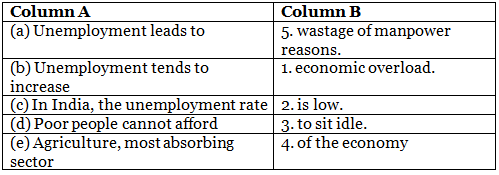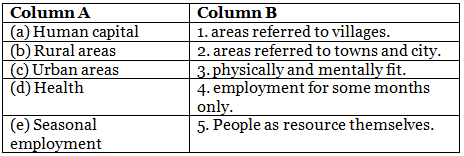Class 9 Economics Chapter 1 Practice Question Answers - Economics
Multiple Choice Questions
Q1: The quality of the population decides the:
(a) birth rate of the country
(b) death rate of the country
(c) growth rate of the country
(d) none of the above
Ans: (c)
The better the quality of the population the better is the growth of the country.
Q2: Literate and healthy population are:
(a) an asset for a country
(b) a liability for the economy
(c) could be both (a) and (b)
(d) none of the above
Ans: (a)
Every country in order to progress wants a literate and healthy population.
Q3: The literacy rates have increased from ………… in 1951 to ………… in 2001.
(a) 18%-45%
(b) 20%-55%
(c) 18%-55%
(d) 18%-65%
Ans: (a)
From 1951 to 2001 literacy rate has increased from 18% to 65%.
Q4: The health of a person helps him to realise his potential and the ability to fight:
(a) the enemy
(b) diseases
(c) illness
(d) none of these
Ans: (c)
‘Health is wealth’, hence the health of a person helps him to fight illness.
Q5: Urban areas have mostly:
(a) educated employment
(b) educated unemployment
(c) educated people
(d) none of the above
Ans: (b)
People tend to shift from rural to urban areas. The population of educated population increases in urban areas and thus, these areas have, more educated unemployment.
Q6: Investment in human capital yields a return just like investment in:
(a) secondary capital
(b) primary capital
(c) physical capital
(d) none of the above
Ans: (c)
Educated people are an asset for the country. Higher income can be earned by better trained people.
Q7: Investment in human resources is the same as investment in:
(a) land
(b) property
(c) land and capital
(d) none of these
Ans: (c)
Since the value of land and capital increases, in the same way investment in human resources can yield high productivity.
Q8: Primary sector includes:
(a) agriculture, forestry, animal hus-bandry, etc.
(b) fishing, quarrying and manufac-turing
(c) trade, transport, banking etc.
(d) none of the above.
Ans: (a)
Primary means the starting. This includes agriculture, forestry, animal husbandry etc.
Q9: Territory sector includes:
(a) agriculture, forestry, animal husbandry etc.
(b) fishing, quarrying and manufacturing
(c) trade, transport, banking etc.
(d) none of the above
Ans: (c)
Tertiary sector comes after primary and secondary sector. This include trades, transport, banking etc.
Q10: Economic activities have two parts:
(a) market activities and sale activities
(b) market activities and non-market activities
(c) only market activities
(d) none of the above.
Ans: (b)
Both market and non-market activities are included in the economic activities.
Fill in the blanks
Q11: The dependence of the ……………. on the working population increases.
Ans: unemployed
The provided answer "unemployed" refers to the people who do not have a job but are actively seeking for one. The dependence of the unemployed people on the working population increases because they need financial support to meet their needs. The working population, through the taxes they pay, helps the government to provide unemployment benefits to the jobless people.
Q12: People who are an ……………. for the economy turn into a liability.
Ans: asset
The answer "asset" refers to people who are beneficial for the economy. This could be through their skills, knowledge, or job that contributes to the economic growth. However, when these people lose their jobs and become unemployed, they turn into a liability. This is because the government has to provide them with financial support and they are no longer contributing to the economy.
Q13: Unemployment has detrimental impact on the overall ……………. of an economy.
Ans: growth
The answer "growth" refers to the increase in the production of goods and services over a certain period. Unemployment has a detrimental impact on this growth because when people are unemployed, they are not contributing to the production process. This leads to a decrease in the overall output of an economy, hindering its growth.
Q14: ……………. employment happens when people are not able to find jobs during some months of the year.
Ans: Seasonal
The term "seasonal" employment refers to the type of job that is not available throughout the year. This is common in certain industries such as agriculture or tourism, where work is available only during certain months. When people are not able to find jobs during some months of the year, it is referred to as seasonal unemployment.
Q15: In case of ……………. unemployment people appear to be employed.
Ans: disguised
In case of "disguised" unemployment, people appear to be employed but they are actually not. This happens when more people are doing a job than what is actually required. As a result, even if some people are removed from the job, the productivity will not be affected. These people are essentially unemployed as their contribution to the work is surplus.
True/False
Q16: ‘People as Resource’ is a way of referring to a country’s working people.
Ans: True
'People as Resource' refers to the working population of a country as they are the ones who contribute to the economy through their productive skills and abilities. The quality of this 'resource' can be improved through investments in education, training, and medical care. Thus, people are an asset for the country.
Q17: In the past in India, a large population has been considered an asset rather than a liability.
Ans: False
In the past, a large population in India was considered more a liability than an asset. This is because resources were limited and a large population led to over-exploitation, leading to poverty, unemployment, and other social issues. However, if properly educated and trained, the population can be turned into a valuable asset.
Q18: Total productivity adds to the growth of the economy.
Ans: True
Total productivity is a measure of the efficiency of production. The more productive a workforce is, the more goods or services are produced, which adds to the economic growth. Therefore, improving the productivity of the workforce, through education and training, can significantly contribute to the growth of the economy.
Q19: Investment in human resources cannot give high rates of return in the future.
Ans: False
Investment in human resources, such as education and health, can bring high rates of return in the future. This is because a well-educated and healthy workforce is more productive, which leads to higher economic output. Therefore, investing in human resources is a long-term strategy for economic growth and development.
Q20: Educated parents are found to invest more heavily on the education of their child.
Ans: True
Educated parents understand the importance of education and are more likely to invest heavily in their child's education. They understand that education is the key to better opportunities and a better future. Therefore, they invest more in their child's education, ensuring they get the best possible education.
Matching Questions
Q21:

Ans:
Q22: 
Ans: 
















